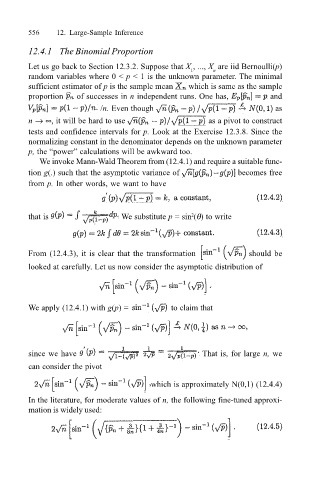Page 579 - Probability and Statistical Inference
P. 579
556 12. Large-Sample Inference
12.4.1 The Binomial Proportion
Let us go back to Section 12.3.2. Suppose that X , ..., X are iid Bernoulli(p)
1
n
random variables where 0 < p < 1 is the unknown parameter. The minimal
sufficient estimator of p is the sample mean which is same as the sample
proportion of successes in n independent runs. One has, and
/n. Even though as
n → ∞, it will be hard to use as a pivot to construct
tests and confidence intervals for p. Look at the Exercise 12.3.8. Since the
normalizing constant in the denominator depends on the unknown parameter
p, the power calculations will be awkward too.
We invoke Mann-Wald Theorem from (12.4.1) and require a suitable func-
tion g(.) such that the asymptotic variance of becomes free
from p. In other words, we want to have
that is We substitute p = sin (θ) to write
2
From (12.4.3), it is clear that the transformation should be
looked at carefully. Let us now consider the asymptotic distribution of
We apply (12.4.1) with g(p) = to claim that
since we have That is, for large n, we
can consider the pivot
which is approximately N(0,1) (12.4.4)
In the literature, for moderate values of n, the following fine-tuned approxi-
mation is widely used:

